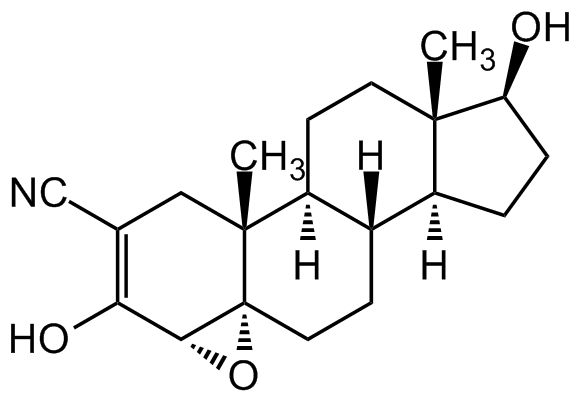Trilostane
| Code | Size | Price |
|---|
| CDX-T0449-M010 | 10 mg | £72.00 |
Quantity:
| CDX-T0449-M050 | 50 mg | £255.00 |
Quantity:
Prices exclude any Taxes / VAT
Overview
Regulatory Status: RUO
Shipping:
AMBIENT
Storage:
Short Term: RT, Long Term: +4°C
Images
Documents
Further Information
Alternate Names/Synonyms:
Desopan; Modrefen; Vetoryl; WIN 24,540
Appearance:
White to off-white powder.
CAS:
13647-35-3
EClass:
32160000
Form (Short):
liquid
GHS Symbol:
GHS07,GHS08
Handling Advice:
Protect from light and moisture.
Hazards:
H315-H319-H361
InChi:
InChI=1S/C20H27NO3/c1-18-7-6-14-12(13(18)3-4-15(18)22)5-8-20-17(24-20)16(23)11(10-21)9-19(14,20)2/h12-15,17,22-23H,3-9H2,1-2H3/t12-,13-,14-,15-,17+,18-,19+,20+/m0/s1
InChiKey:
KVJXBPDAXMEYOA-CXANFOAXSA-N
Long Description:
Chemical. CAS: 13647-35-3. Formula: C20H27NO3. MW: 329.43. Trilostane is an inhibitor of the 3beta-HSDs (3beta-HSD1 and 3beta-HSD2 with Ki values of 0.10 and 1.60 µM, respectively) which plays a role in adrenal steroid biosynthesis. 3beta-hydroxysteroid dehydrogenase (3beta-HSD) type 1 and type 2 isoforms are key enzymes for the biosynthesis of all active steroid hormones. 3beta-HSD1 (type I) is expressed in placenta and peripheral tissues including breast tumors, whereas 3beta-HSD2 (type 2) is expressed in the adrenal gland, ovary and testis. While Trilsotane has been approved for use in the treatment of Cushing?s syndrome in dogs to reduce cortisol, aldosterone and corticosterone levels, it is being investigated as a possible treatment for both breast cancer and prostate cancer to prevent the synthesis of estrogens and androgens from endogenous precursors. Trilostane has also anti-inflammatory and analgesic properties and systemic administration of trilostane directly affected peripheral and brain levels in neuroactive steroids and monoamine turnover, resulting in antidepressant activity.
MDL:
MFCD00199295
Molecular Formula:
C20H27NO3
Molecular Weight:
329.43
Package Type:
Vial
Precautions:
P281-P305 + P351 + P338
Product Description:
Trilostane is an inhibitor of the 3beta-HSDs (3beta-HSD1 and 3beta-HSD2 with Ki values of 0.10 and 1.60 µM, respectively) which plays a role in adrenal steroid biosynthesis. 3beta-hydroxysteroid dehydrogenase (3beta-HSD) type 1 and type 2 isoforms are key enzymes for the biosynthesis of all active steroid hormones. 3beta-HSD1 (type I) is expressed in placenta and peripheral tissues including breast tumors, whereas 3beta-HSD2 (type 2) is expressed in the adrenal gland, ovary and testis. While Trilsotane has been approved for use in the treatment of Cushing?s syndrome in dogs to reduce cortisol, aldosterone and corticosterone levels, it is being investigated as a possible treatment for both breast cancer and prostate cancer to prevent the synthesis of estrogens and androgens from endogenous precursors. Trilostane has also anti-inflammatory and analgesic properties and systemic administration of trilostane directly affected peripheral and brain levels in neuroactive steroids and monoamine turnover, resulting in antidepressant activity.
Purity:
>98% (HPLC)
SMILES:
OC1=C(C#N)C[C@@]2(C)[C@@]3(CC[C@]4([H])[C@]2([H])CC[C@@]5(C)[C@@]4([H])CC[C@@H]5O)[C@@H]1O3
Solubility Chemicals:
Soluble in DMSO (15mg/ml) or DMF (20mg/ml).
Source / Host:
Synthetic
Transportation:
Non-hazardous
UNSPSC Category:
Biochemical Reagents
UNSPSC Number:
12352200
Use & Stability:
Stable for at least 2 years after receipt when stored at +4°C.
References
(1) J.R. Puddefoot, et al.; Expert Opin. Pharmacother. 7, 2413 (2006) (Review) | (2) J.L. Thomas, et al.; J. Ster. Biochem. Mol. Biol. 111, 66 (2008) | (3) T. Machida, et al.; J. Vet. Med. Sci. 70, 317 (2008) | (4) J. Espallergues, et al.; Psychoneuroendocrinol. 34, 644 (2009) | (5) I. Takizawa, et al.; Cancer Lett. 297, 226 (2010) | (6) J.L. Thomas, et al.; J. Ster. Biochem. Mol. Biol. 125, 57 (2011) | (7) Y. Obata, et al.; Intern. Med. 50, 2621 (2011) | (8) J. Espallergues, et al.; Neuropharmacol. 62, 492 (2012) | (9) D. Tung, et al.; Curr. Ther. Res. Clin. Exp. 75, 71 (2013) | (10) J. Lemetayer & S. Blois; Can. Vet. J. 59, 397 (2018)



